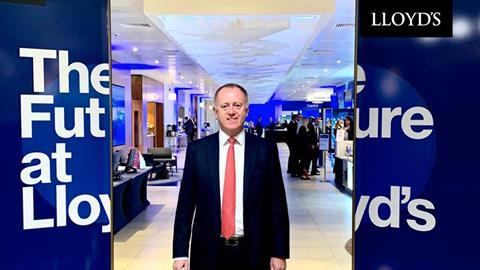Lloyd’s of London will be looking at how it can improve the collection of ethnicity data
John Neal, Lloyd’s of London chief executive, has acknowledged that many firms struggle with their ethnicity data.
This was one of the messages that Neal put forward in Lloyd’s recent report, Ethnic Diversity in the Workplace, which collated data and personal stories from more than 900 employees.
He said: “We know that many firms struggle with the collection of ethnicity data and other characteristics, so we will now be focusing on improving this data collection to enable us to set a market target for ethnicity, as we have for gender, for Q2 2021.”
Peter Blanc, group chief executive at Aston Lark, estimated that 6% of his staff were from a black, Asian or minority ethnic (BAME) background when asked in June.
Although collecting data of this kind is not yet compulsory, it is essential if firms are going to address ongoing issues such as low representation and high turnover. However, some attention must be given to the specific categories used in ethnicity data collection because it is a sensitive issue.
In the report, Lloyd’s also announced its longer term plans to increase BAME representation.
Sensitivities
Speaking at a webinar in September, titled IPS Group: Ethnicity Pay Gap Reporting, Anthony Horrigan, chief executive of Sprktral, pointed out the problematic nature of the acronym BAME, in that it lacks differentiation by putting people into very broad categories that are by no means comprehensive. Many, therefore, see this acronym as not inclusive.
Meanwhile, Aduke Onafowokan, leadership, diversity and inclusion specialist at Inclusivitii, added that there is both cultural and social sensitivities that are unique to ethnicity pay gap reporting.
“Ethnicity is almost primary social categorisation that we all can relate to; it is deeply personal, so people do feel a little bit cautious. There is a bit of vulnerability when asking for that level of disclosure,” she said.
“Historically there have been some negative attributions with disclosure around ethnicity, so people already come into this process a bit afraid. It is very important to have at the back of your mind [for these] data constraints that they are dealing with people’s emotions.”
Onafowokan suggested that firms communicate to staff clearly about why this data is needed, however they should also be aware of the data issues of aligning it with diversity and inclusion purposes.
She added that ethnicity pay gaps have two key drivers: under-representation in senior roles and over-representation in junior roles, as well as the inability to keep diversity in organisations.
Not mandatory
When Insurance Times originally approached the industry in June to gather ethnicity pay gap data and data on the ethnicity of staff, many said that they did not keep such statistics – this is because it is not mandatory for firms to do this.
But movements such as Black Lives Matter has hoisted this up the agenda, as no action can be taken to address the gap if there is no data to base actions on.
Industry response
These were some of the responses Insurance Times previously collected when it approached firms to discuss their ethnicity pay gap data.
Zurich
Zurich revealed that its UK executive is 7% BAME and 3% of its senior UK staff are BAME.
The insurer said that employees self-declare their ethnicity at Zurich UK. The organisation added that it is “working internally to encourage more people to share this information with us as well as explaining why it’s so important. We’re aware that our representation is lower than the industry average of 10% (ABI members) and we’re taking action to address this”.
Zurich aims to reflect the customers it serves.
Allianz
Chief operating officer and member of the Allianz Global Diversity and Inclusion Council Stephanie Smith said: “At Allianz, we’re absolutely committed to ensuring equality in our organisation - we take a zero tolerance approach to discrimination of any kind.
“Over the years we’ve worked hard to foster a diverse and inclusive culture in our organisation and recent events demonstrate why it remains critically important for us to work even harder to do so.
”We have a range of employee networks, including one for race and international cultural heritage, and we’re also active members of the Allianz Global Diversity and Inclusion Council.
“That said, we recognise that we still have a lot more to learn in this complex area. As a company with a diverse workforce we are extremely proud of, we at Allianz denounce all forms of discrimination.”
Aon
Aon’s head of diversity and inclusion Katherine Conway added: “Aon has a strong focus on diversity and inclusion in the UK. We are committed to attracting, retaining and developing diverse talent and reinvigorated our programme on collecting data on the ethnicity of our workforce following the Dive In events we hosted in 2019 on the subject of the BAME pay gap.”
“We have an active programme of training and development to support our D&I goals, encompassing both hard skills and softer cultural and conduct skills. Some of these are targeted directly to attract, develop and retain BAME talent in our firm and our industry and in 2019 and 2020, the intakes on our early careers programmes (apprenticeships, internships and graduates) consisted of 38% and 30% BAME talent respectively.
”We recognise there is much more we can do; our multicultural network is very active and we are working with them closely to evolve our strategy and to increase our momentum.”

Hosted by comedian and actor Tom Allen, 34 Gold, 23 Silver and 22 Bronze awards were handed out across an amazing 34 categories recognising brilliance and innovation right across the breadth of UK general insurance.





















































No comments yet